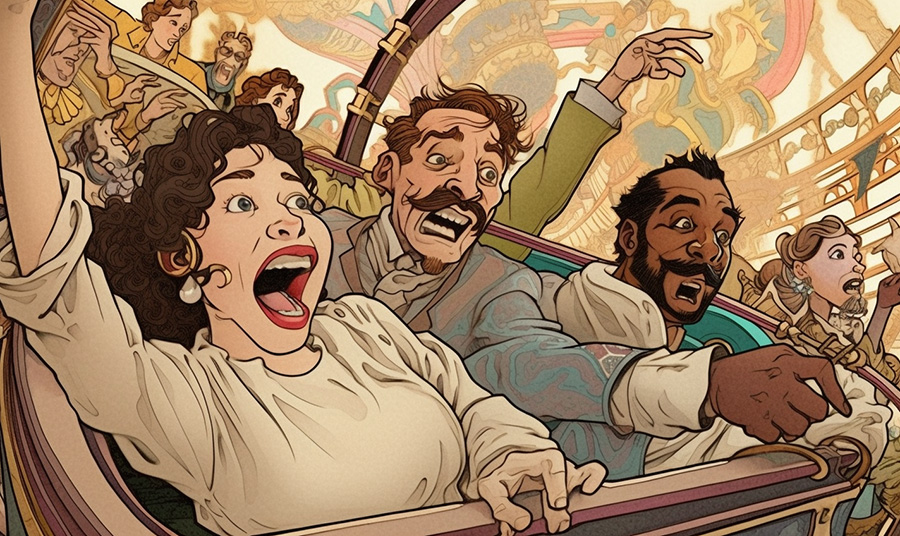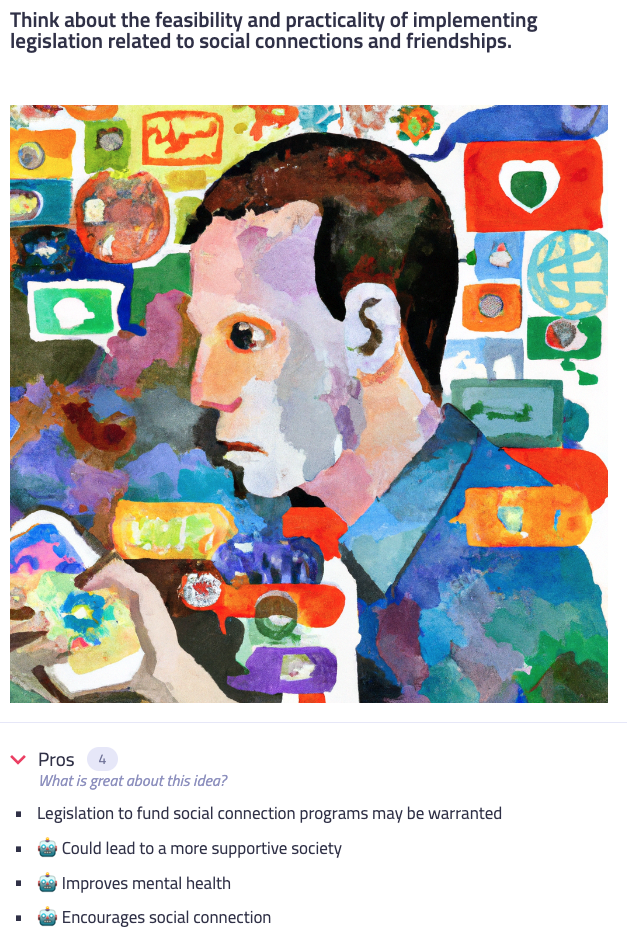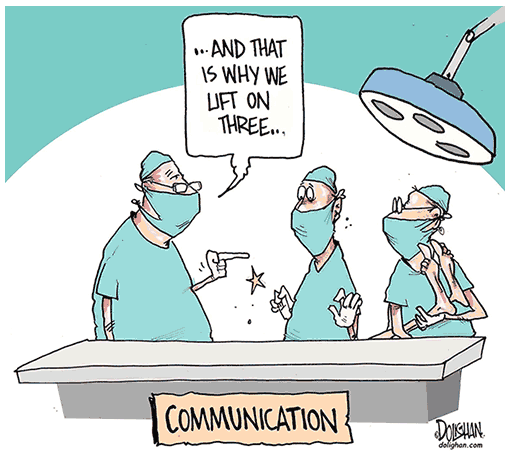How I Learned to Stop Worrying and ❤️ Using AI in Meetings
If you manage collaborative teams, there’s a chance you’re freaking out a bit because AI just changed knowledge work.
I didn’t say “will change.” Has changed. It’s here.
IBM announced a hiring freeze because they believe 30% of their workforce might be replaced by AI. Investing patterns and web traffic are already showing big shifts, and Goldman Sachs is anticipating a 7% increase in global GDP.
There’s opportunity here. Collaborative teams that use AI in meetings can dramatically streamline their work and increase productivity – once they learn how and when to use these tools.
Unfortunately, most teams are overloaded. Global upheaval doesn’t leave folks much time for independent study. The tools are rapidly evolving, too. What we learned in January is nowhere near as exciting as what we can do here in May.
This means that everyone involved in designing, writing, creating, testing, selling, and collaborating is along for a white-knuckle climb to the top of the tracks. The learning curve is steep and it’s not at all clear what we’ll see when we hit the top. Will we enjoy a gentle, delightful acceleration, or are we plummeting straight to the bottom?
It’s exciting. It’s terrifying. Anxiety is warranted.

We have options and gnarly decisions to make. How might we seize the opportunities while minimizing our risks?
In the Meeting Innovation Community, we’re experimenting with using AI in meetings in search of answers. After each experiment, team leaders and facilitators share their worries.
One common concern is that if people use AI to help brainstorm and develop their ideas, they won’t commit to them. They’ll lack “ownership”. Without ownership, they won’t follow through and act on the final results. The worry seems rooted in a belief that people only buy into and act on their own ideas.
If you’ve worried about this too, let it go. We have plenty of problems. This isn’t one of them.
4 Reasons to Stop Worrying About AI in Meetings and Idea Ownership
1. Philosophically: The notion that anyone “owns” ideas is flawed.
“There’s only so many notes and very few chords in pop music, coincidence is bound to happen if 60,000 songs are being released every day on Spotify.
That’s 22 million songs a year – and there’s only 12 notes that are available.”
~ Pop artist Ed Sheeran after winning yet another copyright infringement lawsuit
Every new idea emerges from the collision and intertwining of earlier ideas. As Dr. Matt Ridley says, innovation is what happens when ideas have sex.
While it’s silly to believe that ideas in their raw ephemerality could be owned, we can certainly grow attached to our expression of an idea. The more effort we put into developing an idea, the greater that attachment may become. This is why…
2. Methodologically: Most meetings involving brainstorming are already designed to reduce an individual’s sense of personal idea ownership.
Old-school brainstorming, where folks get in a room and shout ideas at one another, creates all kinds of problems with:
- Groupthink, where all the ideas sound similar as the group becomes trapped within the intellectual box built by the first few ideas shared.
- HiPPO dominance, where the highest-paid person’s opinion gets all the focus.
- False consensus and pluralistic ignorance, where people go along with what they believe the HiPPO or majority ideas might be to avoid conflict.
- Low idea volume, because one loud or slow talker or person who needs to explain their idea in detail takes up all the time.
To avoid these traps, most well-designed brainstorming sessions employ one or more techniques designed to increase idea volume, diversity, and collective ownership.
For example:
- Silent brainstorming: Individuals brainstorm silently in writing and then post their ideas to a shared space. The group then sees a big list of ideas without anyone’s name on them. Together, the group combines ideas, changes them, and iterates. All ideas become “the group’s” because the group works on them together.
- Luma’s Round Robin: Each person proposes an idea, then passes it to another person who lists all the flaws. They pass these flaws to another person, who suggests ways to rework the idea to overcome the flaws. The proposal now includes ideas from multiple people.
- Mute mapping and the KJ Technique: The group organizes lots of individual ideas into groups, then names each group. Going forward, the group will act on and develop the collection, rather than each individual idea.
With processes like these, the commitment to act – the “ownership” we seek – comes from developing and agreeing to a plan of action, not from the origination of the initial idea.
3. Practically: People “own” very few of the ideas they act on.
“People won’t buy into the idea if it wasn’t theirs.”
This is something change leaders and facilitators say all the time, and it’s obviously untrue. It bugs the heck out of me.
Just a few of the many reasons:
A. Laws, standard procedures, schedules, societal norms, what your friend said the other day – our entire civilization works because we go along with millions of decisions made by others.
Everything from changing how you pay your taxes to what you wear to when you take out your garbage may be decided without your input, and you’ll comply.
Society works this way because it must. There are far too many decisions to make and no practical means for getting everyone’s “ownership” for all of them. To suggest that people need to be involved in making a decision in order to act on it denies the ample evidence provided by your entire life.
B. It’s entirely possible to share ideas that you don’t buy into.
New Year’s resolutions are the classic example proving that we can create very elaborate ideas and even plan how to implement them, yet fail to do so.
I realize this personal example may seem irrelevant in a group setting, so let’s consider decisions made in brainstorming meetings.
I once hired a person who was marvelous at connecting with the group on an interpersonal level (always a good time!), brainstormed like a champ (so many great ideas!), committed to the tasks the group agreed on (a real team player!), and then didn’t do squat.
Have you worked with this person too? I bet you have.
Or, have you worked with a manager who thinks that managing means “thinking for the team, coming up with the ideas, and then telling everyone else what to do?”
Either way, you know that just because someone came up with an idea, that’s no guarantee they’re planning to act on it. Buy-in, commitment, and ownership: while all of these feelings may increase the likelihood of a person’s eagerness to act, they are not determinants of success OR failure.
C. It’s entirely possible to “own” ideas you didn’t create.
Another personal example: before we started Lucid Meetings, I worked as a product manager for a legal technology company. The company needed to make a major decision about whether to rebuild the entire software suite from scratch or focus on rebuilding just one part and purchase software to replace everything else.
As the lead product manager, I spent two months researching our options. Then I found a young startup team with new technology that 100% solved one of our biggest problems. Even better: the team was small, hungry, and in need of cash.
I presented my case to the executive team. If we purchased this company, we could save a million dollars and two years of development time. The CEO told me to delete the proposal and never bring it up again.
One month later, the board fired the CEO for lack of performance. The VP of Sales and Marketing then presented the board with his plan to purchase that startup, which was approved. As the company’s profits soared, the VP received a commendation from the board and a fat five-figure bonus. I promptly quit.
My story is not unique. It also illustrates two lessons.
- Folks “own” the ideas that they believe lead to success, regardless of who came up with the idea in the first place.
- Action happens when influential people and the surrounding environment support it.
4. Technically: AI is a tool.
Tools like OpenAI’s ChatGPT can return really interesting ideas when prompted to do so. These tools do not break into a group’s brainstorming meeting and autonomously take over. Moreover, the quality of the ideas they create is dependent on the quality of the prompt.
In practice, people choose what to ask AI, just like they choose what to search for in Google. Each person’s creativity is expressed in the prompt they use and in what they choose to do with the ideas AI returns.
When we incorporated AI into experimental brainstorming sessions, here’s what we saw.
- Participants keyed into the quality of each idea rather than the source.
When an idea was interesting, they talked about it, voted for it, and wanted to explore it more regardless of whether the idea came from a person or from AI (denoted with a ? emoji.) - AI created bad ideas people could react against.
In a recent podcast, the facilitator Douglas Ferguson said, “I know the answer when I see the wrong answer.”
We saw this in our experiments too. Bad ideas highlighted when we were missing the opposite very good ideas.
- AI helped people get unstuck faster.
Humans communicate new ideas in fits and spurts. They may share a rush of ideas, then pause to think for minutes before more ideas emerge.
In that pause, they’re searching for “What else? What’s another way to say that? What angle haven’t I considered?” Unfortunately, they may not find answers before time runs out.
AI can answer these questions in seconds, giving people the inspiration they need to contribute more ideas within the time limit.
- AI can improve the quality of how an idea is communicated.
Thinking of an idea and communicating that idea clearly to others are different skills drawing on different parts of the brain. A person partnering with AI can share a rudimentary outline of their idea, then ask the AI to create more detailed descriptions or images to help communicate it.
For anyone whose ideas are routinely dismissed as boring or unclear, this is a game changer.
An Example from Our Experiments
We experimented by brainstorming solutions to the devastating social isolation many have experienced in the past few years.
The final step of our process was to select an idea and develop it by adding more details. Our candidate ideas were:
- Monthly neighborhood entertainment where everyone contributes
- Build housing with apartments for seniors and students, with a visual board in the 1st floor to connect them via activities (game night, …) and requests (help with repairing something)
- VR Social Platform, enabling anyone who activates it to immediately be connected with another human nearby, and an option to suggest meeting places where they can join others in group activities
- Think about the feasibility and practicality of implementing legislation related to social connections and friendships.
Which would you have picked? I was excited to build out any of the first three ideas. I could envision them and they sounded fun! But instead, the group selected the “think about legislation” option. They wanted to see whether AI could make anything out of this very vague concept.
I was disappointed. I thought the idea was uninspiring and a waste of our time. If it had been a real meeting with real stakes, I would have pushed back on investing the group’s energy in this boring idea.
But since it was an experiment, we invited AI to build out that idea by listing some Pros (Government focus could lead to a more supportive society), Cons (May be seen as infringing on personal freedom), Possible Improvements (Legislation could focus on creating funds, community spaces, and support infrastructure), and Possible Implementations (Conduct research on existing legislation related to social connections and friendships). 30 seconds elapsed and I was slapped in the face with my bias. What I had dismissed out of hand suddenly had potential. I could see how exploring this idea might lead to new opportunities that we hadn’t yet considered.

The idea as expressed by a human (who was forced to quickly type under pressure) was ho-hum. The idea as expressed by a human working together with AI opened up a great conversation.
Other Ways Folks Worry about Using AI-Generated Content in Meetings
The worry over ownership came up most often, but it wasn’t the only one. Leaders and facilitators also worry that:
? People will get lazy, not bothering to think through ideas.
C’mon now. In what way is this unique to working with AI?
If the people in your group don’t care enough to consider the problem deeply, then it seems MORE risky to ignore AI. At least with AI, you aren’t limited to the group’s tepid ideas.
? AI will lie to us, and the group will act on false info.
This is very likely. AI does not generate reliable or predictable results. As Ethan Mollick suggests: AI is not good software. It is pretty good people. Everyone working with AI-generated content today must add a fact-checking step before acting on what they’re given.
? The group will spend their time playing with AI instead of doing the work.
I wish! Play at work is the number one employee motivational factor. Problem-solving that’s fun? Sign me up!
That said, it’s a tool. From personal experience, I can share that the novelty factor does wear off. Then it becomes work again.
? AI-created ideas will be of low quality.
It’s very likely AI will offer some terrible ideas. As mullets suggest, humans also have terrible ideas.

In practice, “bad” ideas can be quite helpful because seeing the bad ideas makes it easier to spot the good ones.
There’s a secondary benefit to this phenomenon. Some people may have an idea that they worry might be bad, but it might also be good. They may not feel they can share it when all the ideas they see are of-a-type. Using AI to broaden the conversation can reduce the risk of sharing unique ideas.
? Data privacy and security
100% worry about this. ICYMI: Samsung learned about this risk the hard way.
Never send private or sensitive data through a publicly accessible tool. When working with a 3rd-party application that uses AI, find out how they handle your data.
My recommendation: Use AI in your creative brainstorming meetings.
Rather than remove ownership in creative brainstorming meetings, I believe AI can increase it by:
- Iterating faster. AI makes it much easier to find an interesting thread and explore it.
- Quickly unblocking folks who are coming up blank.
- Giving groups more time to talk about and develop ideas, because you don’t have to spend as much time generating ideas at the start.
- Improving people’s ability to communicate a complete idea in writing and visuals.
I’m recommending that you and your group use AI-generated content in your meetings. This means that one or more people will need a device and you’ll spend at least some time typing rather than talking.
It also means that you should change how you use the time in your meeting. Spend less time generating or sorting ideas and more time discussing and developing them.
Finally, it also means you need fewer people.
This leads to the final concern I heard from leaders and facilitators.
“We shouldn’t use computers in our meetings, because then people will multitask. When we gather a group, it’s all about the human connection. The human connection matters more than anything else.”
Horse crap.
If your group has real goals, the group gathers to create a shared understanding and inform desirable future action.
It’s all about how NOW shapes NEXT.
Human connection is desirable because it feels good and it makes future action easier. If using AI also makes future action easier by letting your group spend less time generating throw-away lists of ideas and more time working through the details of your plan, you should use it.



